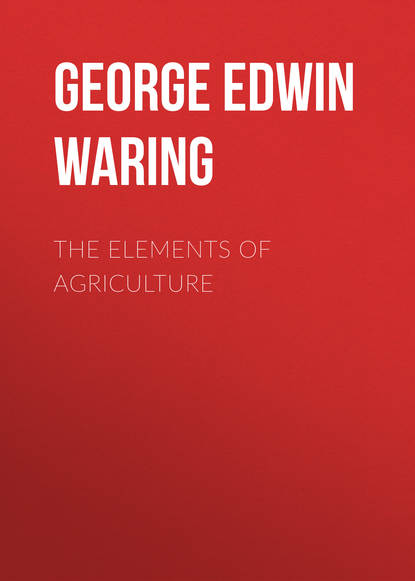По всем вопросам обращайтесь на: info@litportal.ru
(©) 2003-2024.
✖
The Elements of Agriculture
Настройки чтения
Размер шрифта
Высота строк
Поля
How does it produce sorrel in the soil?
How may the acidity be overcome?
It is a constituent of many plants. It also furnishes them with sulphur—a constituent of the sulphuric acid which it contains.
It is an excellent absorbent of ammonia, and is very useful to sprinkle around stables, poultry houses, pig-styes, and privies, where it absorbs the escaping gases, saving them for the use of plants, and purifying the air, thus rendering stables, etc., more healthy than when not so supplied.
It has been observed that the extravagant use of plaster sometimes induces the growth of sorrel. This is probably the case only where the soil is deficient in lime. In such instances, the lime required by plants is obtained by the decomposition of the plaster. The lime enters into the construction of the plant, and the sulphuric acid remains free, rendering the soil sour, and therefore in condition to produce sorrel. In such a case, an application of lime will correct the acid by uniting with it and converting it into plaster.
CHLORIDE OF LIME
What does chloride of lime supply to plants?
How does it affect manures?
How may it be used?
How may magnesia be supplied, when wanting?
What care is necessary concerning the use of magnesia?
Chloride of lime is a compound of lime and chlorine. It furnishes both of these constituents to plants, and it is an excellent absorbent of ammonia and other gases arising from decomposition—hence its usefulness in destroying bad odors, and in preserving fertilizing matters for the use of crops.
It may be used like plaster, or in the decomposition of organic matters, where it not only hastens decay, but absorbs and retains the escaping gases. It will be recollected that chloride of lime is one of the products of the lime and salt mixture.
Lime in combination with phosphoric acid forms the valuable phosphate of lime, of which so large a portion of the ash of grain, and the bones of animals, is formed. This will be spoken of more at length under the head of 'phosphoric acid.'
MAGNESIA
Magnesia is a constituent of vegetable ashes, and is almost always present in the soil in sufficient quantities. When analysis indicates that it is needed, it may be applied in the form of magnesian lime, or refuse epsom salts, which are composed of sulphuric acid and magnesia (sulphate of magnesia).
The great care necessary concerning the use of magnesia is, not to apply too much of it, it being, when in excess, as has been previously remarked, injurious to the fertility of the soil. Some soils are hopelessly barren from the fact that they contain too much magnesia.
ACIDS
SULPHURIC ACID
What is sulphuric acid commonly called?
How may it be used?
How does it prevent the escape of ammonia?
Sulphuric acid is a very important constituent of vegetable ashes, especially of oats and the root-crops.
It is often deficient in the soil, particularly where potatoes have been long cultivated. One of the reasons why plaster (sulphate of lime) is so beneficial to the potato crop is undoubtedly that it supplies it with sulphuric acid.
Sulphuric acid is commonly known by the name of oil vitriol, and may be purchased for agricultural purposes at a low price. It may be used in a very dilute form (weakened by mixing it with a large quantity of water) to the compost heap, where it will change the ammonia to a sulphate as soon as formed, and thus prevent its loss, as the sulphate of ammonia is not volatile; and, being soluble in water, is useful to plants. Some idea of the value of this compound may be formed from the fact that manufacturers of manures are willing to pay seven cents per lb., or even more, for sulphate of ammonia, to insure the success of their fertilizers. Notwithstanding this, many farmers persist in throwing away hundreds of pounds of ammonia every year, as a tax for their ignorance (or indolence), while a small tax in money—not more valuable, nor more necessary to their success—for the support of common schools, and the better education of the young, is too often unwillingly paid.
What is the effect of using too much sulphuric acid?
If a tumbler full of sulphuric acid (costing a few cents), be thrown into the tank of the compost heap once a month, the benefit to the manure would be very great.
Where a deficiency of sulphuric acid in the soil is indicated by analysis, it may be supplied in this way, or by the use of plaster or refuse epsom salts.
Care is necessary that too much sulphuric acid be not used, as it would prevent the proper decomposition of manures, and would induce a growth of sorrel in the soil by making it sour.
In many instances, it will be found profitable to use sulphuric acid in the manufacture of super-phosphate of lime (as directed under the head of 'phosphoric acid,') thus making it perform the double purpose of preparing an available form of phosphate, and of supplying sulphur and sulphuric acid to the plant.
PHOSPHORIC ACID
How large a part of the ashes of grain consists of phosphoric acid?
Of what other substances does it form a leading ingredient?
How many pounds of sulphuric acid are contained in one hundred bushels of wheat?
We come now to the consideration of one of the most important of all subjects connected with agriculture, that is, phosphoric acid.
Phosphoric acid, forming about one half of the ashes of wheat, rye, corn, buckwheat, and oats; nearly the same proportion of those of barley, peas, beans and linseed; an important ingredient of the ashes of potatoes and turnips; one quarter of the ash of milk and a large proportion of the bones of animals, often exists in the soil in the proportion of only about one or two pounds in a thousand. The cultivation of our whole country has been such, as to take away the phosphoric acid from the soil without returning it, except in very minute quantities. Every hundred bushels of wheat sold contains (and removes permanently from the soil) about sixty pounds of phosphoric acid. Other grains, as well as the root crops and grasses, remove likewise a large quantity of it. It has been said by a contemporary writer, that for each cow kept on a pasture through the summer, there is carried off in veal, butter and cheese, not less than fifty lbs. of phosphate of lime (bone-earth) on an average. This would be one thousand lbs. for twenty cows; and it shows clearly why old dairy pastures become so exhausted of this substance, that they will no longer produce those nutritious grasses, which are favorable to butter and cheese-making.
How much phosphate of lime will twenty cows remove from a pasture during a summer?
What has this removal of phosphate of lime occasioned?
How have the Genesee and Mohawk valleys been affected by this removal of phosphoric acid?
That this removal of the most valuable constituent of the soil, has been the cause of more exhaustion of farms, and more emigration, in search of fertile districts, than any other single effect of injudicious farming, is a fact which multiplied instances most clearly prove.
It is stated that the Genesee and Mohawk valleys, which once produced an average of thirty-five or forty bushels of wheat, per acre, have since been reduced in their average production to twelve and a half bushels. Hundreds of similar cases might be stated; and in a large majority of these, could the cause of the impoverishment be ascertained, it would be found to be the removal of the phosphoric acid from the soil.
How may this devastation be arrested?
Is any soil inexhaustible?
What is usually the best source from which to obtain phosphoric acid?
The evident tendency of cultivation being to continue this murderous system, and to prey upon the vital strength of the country, it is necessary to take such measures as will arrest the outflow of this valuable material. This can never be fully accomplished until laws shall be made preventing the wastes of cities and towns. Such laws have existed for a long time in China, and have doubtlessly been the secret of the long subsistence and present prosperity of the millions of people inhabiting that country.
We have, nevertheless, a means of restoring to fertility many of our worn-out lands, and preserving our fertile fields from so rapid impoverishment as they are now suffering. Many suppose that soils which produce good crops, year after year, are inexhaustible, but time will prove to the contrary. They may possess a sufficiently large stock of phosphoric acid, and other constituents of plants, to last a long time, but when that stock becomes so reduced, that there is not enough left for the uses of full crops, the productive power of the soil will yearly decrease, until it becomes worthless. It may last a long time, a century, or even more, but as long as the system is—to remove every thing, and return nothing,—the fate of the most fertile soil is evident.
The source mentioned, from which to obtain phosphoric acid, is the bones of animals. These contain large quantities of phosphate of lime. They are the receptacles which collect nearly all of the phosphates in crops, which are fed to animals, and are not returned in their excrements. For the grain, etc., sent out of the country, there is no way to be repaid except by the importation of this material; but, all that is fed to animals, or to human beings, may, if a proper use be made of their excrement, and of their bones after death, be returned to the soil. With the treatment of animal excrements we are already familiar, and we will now turn our attention to the subject of
BONES
Of what do dried bones consist?
What is the organic matter of bones?






